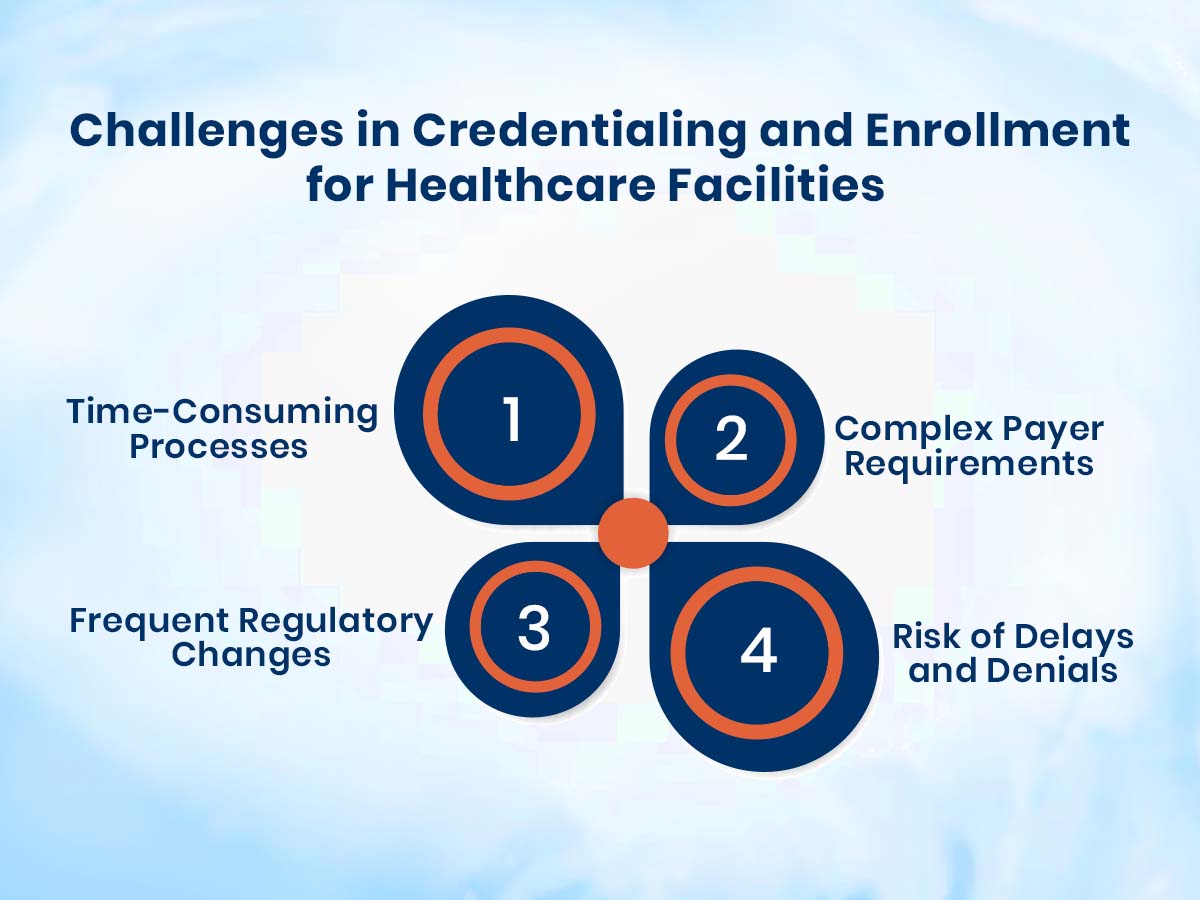In the healthcare industry, credentialing and enrollment for healthcare facilities is a vital process that ensures providers meet professional standards and can legally offer services while being reimbursed by insurance payers. This process impacts patient trust, operational efficiency, and the financial health of facilities.
In this guide, we’ll explore the importance, steps, challenges, and strategies for optimizing credentialing and enrollment for healthcare facilities to achieve seamless operations and compliance.
What is Credentialing and Enrollment for Healthcare Facilities?
Credentialing is the process of verifying healthcare providers’ qualifications, such as licenses, education, certifications, and experience. It confirms that providers meet the necessary standards to deliver quality care.
Enrollment refers to the registration of healthcare providers with insurance networks and government payers (like Medicare and Medicaid) to enable them to bill for services rendered.
Together, credentialing and enrollment for healthcare facilities ensure that providers can operate efficiently and receive timely reimbursements.
Why Credentialing and Enrollment for Healthcare Facilities is Crucial
- Ensures Compliance
Proper credentialing confirms that providers adhere to local, state, and federal regulations, safeguarding facilities from legal risks. - Facilitates Reimbursements
Enrollment with insurance networks ensures that healthcare facilities can bill and receive payments for services provided, minimizing revenue loss. - Builds Patient Trust
Patients are more likely to trust healthcare facilities that employ credentialed providers, knowing they meet professional standards. - Reduces Administrative Errors
Streamlined processes for credentialing and enrollment for healthcare facilities reduce the likelihood of errors, delays, or claim denials. - Strengthens Financial Stability
Credentialing and enrollment prevent revenue leakage by ensuring providers are properly registered to receive payments from all eligible payers.
Steps in Credentialing and Enrollment for Healthcare Facilities
- Gather Provider Information
Start by collecting essential documents and details for each healthcare provider, including:
- Licenses and certifications
- Medical education and training records
- Work history
- Malpractice insurance details
- Drug Enforcement Administration (DEA) certification
- Verify Provider Credentials
Credentialing requires verifying all information with primary sources, such as medical schools, licensing boards, and previous employers. This step ensures accuracy and compliance.
- Submit Credentialing Applications
Prepare and submit applications to:
- State medical boards
- Accrediting bodies (e.g., The Joint Commission)
- Insurance payers and government programs
Each organization has specific requirements, so careful attention to detail is critical.
- Enroll Providers with Insurance Networks
Enrollment involves completing payer-specific applications and registering providers to bill insurers, including Medicare and Medicaid. Follow-up is often required to confirm approval and resolve any issues.
- Maintain Compliance
Credentialing is not a one-time process. Healthcare facilities must monitor and renew licenses, certifications, and insurance enrollments regularly to ensure providers remain in good standing.
Challenges in Credentialing and Enrollment for Healthcare Facilities

- Time-Consuming Processes
Credentialing and enrollment can take weeks or even months, delaying providers’ ability to deliver and bill for services. - Complex Payer Requirements
Each payer has unique forms and criteria, making the process intricate and error-prone. - Frequent Regulatory Changes
Staying compliant with ever-changing regulations can overwhelm healthcare administrators. - Risk of Delays and Denials
Incomplete or incorrect applications lead to delays in approvals and possible claim denials.
Strategies for Optimizing Credentialing and Enrollment for Healthcare Facilities
- Use Credentialing Software
Invest in software solutions designed to automate and manage credentialing and enrollment processes. These tools reduce manual errors and provide real-time updates on application statuses.
- Centralize Provider Information
Maintain a centralized, digital repository of all provider data to ensure easy access and quick updates. This prevents duplication and simplifies re-credentialing.
- Outsource to Credentialing Experts
Many healthcare facilities choose to outsource credentialing and enrollment tasks to specialized agencies. These experts bring in-depth knowledge and handle the complexities, freeing up in-house resources.
- Stay Proactive with Renewals
Track expiration dates for licenses, certifications, and insurance and ensure timely renewal to avoid lapses in compliance or enrollment status.
- Train Administrative Staff
Equip staff with the knowledge and tools to handle credentialing and enrollment for healthcare facilities efficiently. Regular training ensures they stay updated on best practices and regulatory changes.
Key Metrics to Monitor in Credentialing and Enrollment
- Turnaround Time
Measure the time taken to complete credentialing and enrollment for providers. - Enrollment Approval Rate
Track the percentage of successful applications submitted to payers. - Claim Denial Rate
Monitor denials related to credentialing or enrollment issues. - Compliance Rate
Ensure all providers maintain active and up-to-date credentials.
How Credentialing and Enrollment Impact Revenue Cycle Management
Credentialing and enrollment are integral to revenue cycle management (RCM). Without proper enrollment, healthcare facilities cannot bill insurance payers, resulting in lost revenue. Accurate credentialing ensures that providers meet payer standards, reducing the risk of denials and delayed reimbursements.
By integrating credentialing and enrollment for healthcare facilities with RCM processes, organizations can:
- Improve claim acceptance rates.
- Shorten reimbursement cycles.
- Enhance overall financial performance.
Future Trends in Credentialing and Enrollment for Healthcare Facilities
The future of credentialing and enrollment for healthcare facilities is being shaped by technology and innovation. Emerging trends include:
- Artificial Intelligence (AI): Automating verification and application processes for faster turnarounds.
- Blockchain Technology: Providing secure, transparent, and efficient data sharing for credentialing.
- Integrated RCM Systems: Combining credentialing and enrollment with other RCM functions for a seamless workflow.
Conclusion
Credentialing and enrollment for healthcare facilities** are essential for ensuring compliance, maintaining operational efficiency, and achieving financial stability. By adopting streamlined workflows, leveraging technology, and staying proactive, healthcare organizations can optimize these processes and focus on delivering exceptional patient care.
Are you ready to improve your credentialing and enrollment for healthcare facilities? Partner with experts or adopt cutting-edge solutions to simplify the process and secure your financial success.





